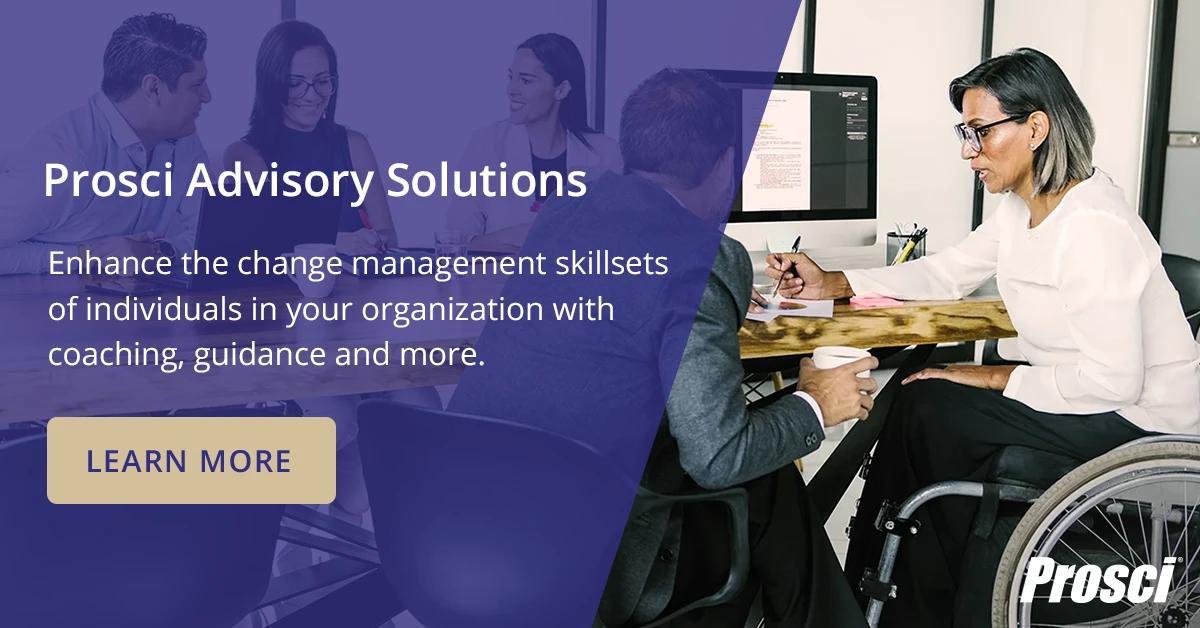When Should You Use a Change Management Readiness Assessment?

4 Mins
Updated: January 17, 2023
Published: September 30, 2020

Change management assessments are commonly touted by consultants as a key step in the change management process. Are they necessary? What is their value and when should you use them?
Assess the Change
When managing change, you need two critical assessments at the onset of a change. The first is of the change itself. This assessment examines the scope, depth and overall size of the change, and should address:
- Scope of the change (workgroup, department, division, enterprise)
- Number of employees impacted
- Type of change (process, technology, organization, job roles, merger, strategy)
- Amount of change from where we are today
This assessment of the change and a thoughtful review of the nature of the change are essential to plan your change strategy.
If you need help getting started or you're not sure what to do after completing the readiness assessment,
Prosci's Advisory Solutions team can help. 
Assess the Organization
The second assessment is of the organization. Every organization has unique characteristics that make change management either easy or challenging. Understanding these organizational attributes enables you to educate your team and sponsors about potential obstacles. This assessment covers:
- Culture and value system
- Capacity for change (and how much change is already taking place)
- Leadership styles and power distribution
- Residual effects of past changes
- Middle management's predisposition toward the change
- Employee readiness for change
Culture and value system
Culture and value system play a major role in how an organization reacts to change. Giving thought to this enables you to predict certain reactions from the group and plan accordingly to deal with those reactions.
Capacity for change
Organizations have a limited capacity for change. If your organization is already experiencing large amounts of change, implementing yet another can be more difficult.
Leadership style
Leadership styles play an important role in change management planning. Because sponsorship and management support is a key success factor in change management, it is important to spend sufficient time assessing the leadership styles and power distribution in your organization.
Past changes
Past changes may have left residual effects that could work in your favor or make change management more challenging. Your organization's history is part of your starting point when managing change.
Predisposition of middle managers
In many organizations, some middle managers can have a high degree of control over their peers and employees. They may be strong leaders or feared by others. These middle managers will play a significant role in the change process.
Employee readiness
Employee readiness is a gauge of how prepared and able employees are for change, whether you can expect high or low employee resistance, and the reasons behind the resistance.

Data collection for readiness assessments
How the assessments are completed depends on the make-up of your project team and the role outside experts play in the process. If you use outside consultants for change management, they have little choice but to use standard data collection methods, including employee and manager interviews and surveys. When collecting data from a large number of employees, focus groups can also be used in place of one-on-one interviews.
If internal managers lead your change management efforts and the project team is representative of the groups impacted by the change, there will be a reduced need for data gathering. Often these managers will already have the needed insights about characteristics of the change and organizational attributes. You may only need to collect a subset of data from employees to augment the existing team knowledge.
What is readiness assessment data used for?
Readiness assessment data helps with change management planning. Specifically, you use the information to prepare a change management strategy that fits both the change and your organization's unique attributes. This includes:
- Selecting a change management team model and team size
- Selecting a sponsorship model and support system
- Assessing the risks and identifying potential obstacles
- Determining if any special tactics are necessary to support this change
- Customizing the communication plan, training plan, coaching plan and sponsor plan
What data should you collect from employees?
Execute employee data-gathering carefully and in context with a good change management framework. In many cases, simply asking employees these questions creates fear and uncertainty. This can be troublesome if your project team and senior leadership are not ready to respond to the questions that naturally arise when employees know change is on the horizon. When collecting data, three areas are important:
- Employee perceptions of the organization's readiness for change
- Employee personal readiness for change in general
- Employee understanding of the change itself and how they perceive the personal impact of that change
The last area must be timed carefully with the overall change management communications plan and the project team's readiness with details about the change. In particular, they will need to answer "What's in it for me?" (WIIFM) questions from employees, who first assess change in terms of personal impacts before relating to the broader effects on the organization.
Here are a few examples of statements you can use to rate how employees perceive the change and its impact on them personally:
- The change supports my professional career plans and goals.
- The change will improve my financial position.
- I will not have to relocate to support this change.
- I do not view my job as at risk with this change.
- This change would ultimately benefit my family.
- I am confident that I can learn the new skills and behaviors to perform my new job.
- The change will not adversely affect my health.
- The change will result in a more enjoyable work environment.
Note that these assessment areas are related to family, health, career and finances. You can use statements like these in an assessment tool that asks the employee to rate the degree to which they agree with or disagree with the statement. For example, "On a scale of 1 to 5, with 1 indicating strong disagreement and 5 indicating strong agreement, evaluate each of the following statements." Then you can tabulate the scores by group, department and division to create a profile for each area.
Example statements for assessing employee perception of the organization include:
- Most changes in my organization in the past have been implemented successfully.
- The organization rewards and celebrates successful change.
- The organization takes care of employees that are adversely impacted by change.
- Middle managers have been advocates for change in the past.
- Executives in this organization are visible and active change leaders and sponsors.
- The organization encourages and rewards employees that promote change and introduce new ideas.
- I view my peers and work colleagues as willing and able to embrace change.
- My management team is receptive to feedback and alternative ideas, and encourages open communication.
These statements relate to how the employee perceives key attributes of the organization, including the culture and leadership style.
Pulling It All Together
Conducting these assessments with the right change management framework can be useful for planning your change management strategy and helping the project team make informed decisions about their change management approach. It's important to understand that the assessment process is a planning aid and not the bulk of the change management effort. As tools that help your team plan for the change, assessments should consume minimal time—just enough to inform good planning decisions.


